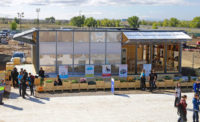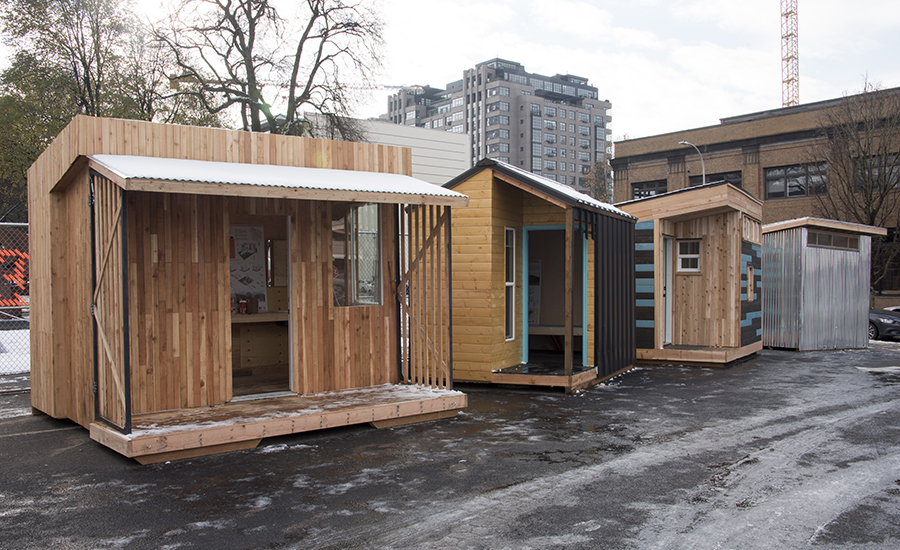Can Tiny Homes Help Solve America’s Big Homelessness Problem?

In June, the Kenton Women’s Village opened in Portland—a project initiated in 2016 by the Center for Public Interest Design at Portland State University.
Photo © Mark Stein

The Center and several partners hosted a design charrette to discuss solutions, and then organized a public expo showcasing 14 sleeping pods created by local architects and students.
Photo © Mark Stein

The Community First! Village in Austin, known locally as Tiny Town, opened in 2015 and contains 240 housing units.
Image courtesy Mobile Loaves and Fishes

The Community First! Village in Austin, known locally as Tiny Town, opened in 2015 and contains 240 housing units.
Image courtesy Mobile Loaves and Fishes

The Community First! Village in Austin, known locally as Tiny Town, opened in 2015 and contains 240 housing units.
Image courtesy Mobile Loaves and Fishes

The housing units range from RVs and safari-style canvas tents to stick-built micro homes.
Image courtesy Mobile Loaves and Fishes

The housing units range from RVs and safari-style canvas tents to stick-built micro homes.
Image courtesy Mobile Loaves and Fishes

The housing units range from RVs and safari-style canvas tents to stick-built micro homes.
Image courtesy Mobile Loaves and Fishes

Beloved Community Village will be Colorado’s first tiny home complex for the homeless when it opens this summer.
Photo © Jenna M. McKnight

The village will encompass a shared bathing facility and 11 sleeping units that can each accommodate two occupants.
Photo © Jenna M. McKnight










The tiny house movement has gained considerable momentum in the past decade, with legions of Americans entranced by the notion of leading a simple, clutter-free life in a diminutive abode. Now, the movement is taking on a new dimension, as micro dwellings are being deployed to address a major humanitarian issue: homelessness.
Tiny home villages for the unsheltered are emerging throughout the United States, particularly in the West, where homeless populations are rising. The federal government estimates there are at least 560,000 homeless individuals in the country (though the actual figure is thought to be much higher)—and a large portion of them are based in California, Oregon, Washington, and other western states.
The villages vary in terms of context and scale, although most occupy slivers of land in urban cores and comprise low-tech, moveable pods measuring less than 200 square feet. The dwellings are typically funded by nonprofit groups and built by volunteers. Advocates note that tiny houses are preferable to tent camps and shelter beds because the little cabins are sturdier and have lockable doors. “Nobody likes a tent city, not even homeless people. They’d rather be in something warmer and more resilient,” says Mark Lakeman, a prominent community-focused designer in Portland, Oregon, and cofounder of nonprofit group, The City Repair Project.
In many instances, architects are being engaged in the creation of tiny villages, and in some cases they are even spearheading them. In June, the Kenton Women’s Village opened in Portland—a project initiated in 2016 by the Center for Public Interest Design at Portland State University. The idea took root after the city council declared homelessness a state of emergency. The Center and several partners, including Lakeman, hosted a design charrette to discuss solutions, and then organized a public expo showcasing 14 sleeping pods created by local architects and students. The ultimate goal was to convince the city to adopt the village model as a strategy for addressing homelessness. “We didn’t have a site or funding. We just wanted to force the issue, and use architecture as activism,” says Todd Ferry, a research associate at the center.
In the end, the city funneled money toward the initiative and granted use of a vacant, one-acre lot in the Kenton neighborhood. The expo structures, each 8-by-12 feet, were transferred to the site, and landscaping and communal facilities for cooking and bathing were installed. While not the first such village in Portland, it is the first sponsored by the local government. “We’re setting a precedent to do this elsewhere in the city,” says Ferry.
In Denver, where the homeless population is surging, a similar project is underway. Designed by Radian Inc., a nonprofit architecture and urban planning firm, Beloved Community Village will be Colorado’s first tiny home complex for the homeless when it opens this summer. Located in the River North Art District, the village will encompass a shared bathing facility and 11 sleeping units that can each accommodate two occupants. Solar panels will generate electricity, water tanks will be delivered to the site, and waste will be hauled off by truck. The project is backed by a group of organizations known as the Colorado Village Collaborative.
Viewed as a pilot project, the village can occupy the site for only 180 days. The Collaborative is hunting for new locations while also hoping the zoning permit will be extended. Given this transient condition, the design team had to ensure every element of the village could operate without permanent infrastructure, and could endure relocation—perhaps even constant relocation. “It’s a complex design exercise,” says Tim Reinen, executive director of Radian. “We’re thinking about everything: how we can move it, how it will be occupied, how we build it with volunteers, how we design it to be completely off-grid.” Moreover, they are thinking about how to engender a sense of community, which will be critical to the project’s success.
Rhonda Romero, 48, is one of the incoming residents at the Denver village. She has spent years sleeping in shelters, which are “full of bad influences and temptations,” and camping at various sites, where her belongings are vulnerable to thieves. Having her own secure home will bring a sense of self-worth and accomplishment, she explains. “I’ve never had my own place,” she says. “My bed is going to be mine. It’s not going to be gone.” The tiny home village model could go a long way toward getting people off the streets, she adds: “I think it’s opening a door to the end of homelessness.”
While concentrated in the West, villages are popping up in other locations, including Nashville, Tennessee, and Newfield, New York. Andrew Heben, an urban planner and author of the 2014 book Tent City Urbanism, helped start a tiny home village in Oregon and estimates there are at least a dozen such villages now in operation around the country. “This alternative shelter model first emerged in more progressive cities in the Northwest, but it has begun to be considered in more and more cities as the seemingly intractable issue of homelessness continues to persist,” he said. His organization, SquareOne Villages, has consulted with more than three dozen cites interested in adopting the model.
The villages are not without criticism. Beyond the not-in-my-backyard issues that arise, some homeless advocates question whether the money used to fund these projects should go toward permanent housing instead. Proponents of the village model argue, however, that it is a fast and cost-effective solution to a problem that requires immediate action. “Obviously, we would like to build permanent housing for everyone,” says Aaron Long of the Low Income Housing Institute in Seattle, where homelessness has been declared a state of emergency, like nearby Portland. “But a permanent housing project from start to finish takes three years. There are 5,000 homeless people on our streets, and we can house some of them immediately with this solution.”
In Austin, Texas, the charity group Mobile Loaves & Fishes has established a tiny home village that is meant to be permanent. After donating RVs to homeless people and witnessing the positive impacts, the group’s founder, Alan Graham, began to envision an “RV park on steroids.” In 2006, he and his team started work on creating such a place. “It was a struggle to find attractive land that we could easily develop,” he says. “We had to move outside the city limits to get around zoning laws and the ‘not-in-my-backyard’ efforts.”
They ultimately found a 27-acre property and enlisted architects to help masterplan the site and its structures. They even teamed up with AIA Austin to host a tiny house design competition. “We wanted to create homes that were small in scale, but had attractive architectural elements, so that no matter who came into the community, they would all leave saying ‘I want to live here,’” Graham explains.
The Community First! Village, known locally as Tiny Town, opened in 2015 and contains 240 housing units, ranging from RVs and safari-style canvas tents to stick-built micro homes. It also features shared cooking, laundry, restroom, and bathing facilities, along with a medical clinic and a chapel. Tenants pay up to $380 a month to live in the village, and plans are underway for a 24-acre expansion. Graham hopes residents will stay indefinitely. “Having a permanent home,” he says, “is a core component of the healing process for our friends who are coming out of chronic homelessness.”














